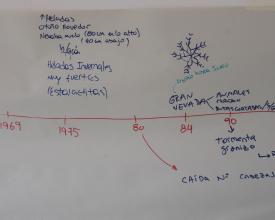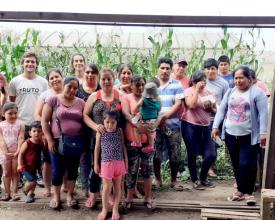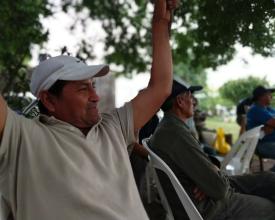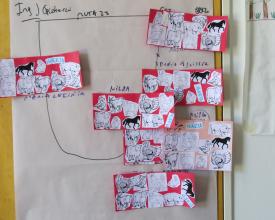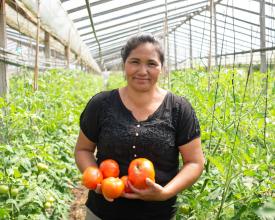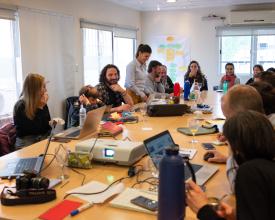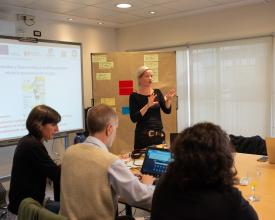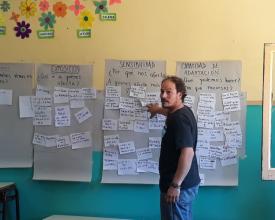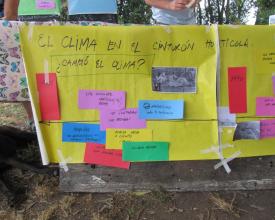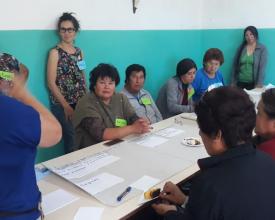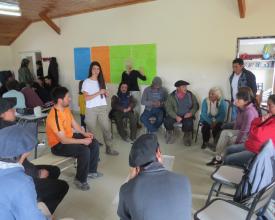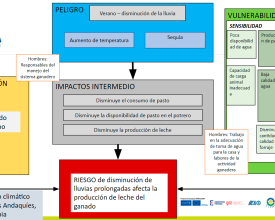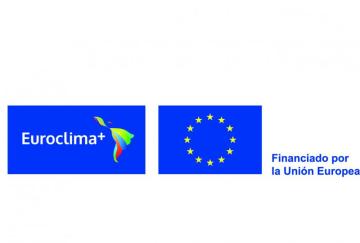
Family Farming Families in Argentina and Colombia carry out participatory analysis of their climate risks.
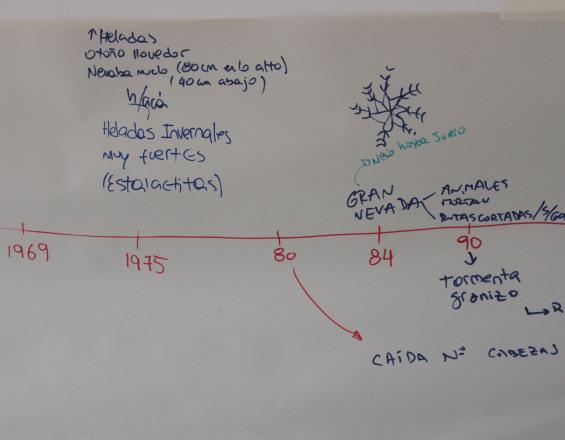
This Solution describes a methodology for the identification of climate risks in family farming according to the concept of the Intergovernmental Panel on Climate Change (IPCC).
The objective is to systematize a methodology for the co-design and co-construction of adaptation measures based on a participatory diagnosis, applying and translating the IPCC AR5 concept, between technical teams and producer families.
The method is based on the perception of the producers, "mechando" with past meteorological data and projections; adding technical advice on adaptation measures to respond to the identified risk, and reflecting together on climate hazards, exposures to these hazards, vulnerabilities and intermediate impacts.
This solution was developed within the framework of the Resilient Project of the EUROCLIMA+ program, financed by the European Union, in the Resilient Food Production sector.
Context
Challenges addressed
The main challenge addressed by this solution (Participatory climate risk analysis) is fundamentally the incorporation of a methodological tool that serves to analyze problems related to climate variability and to identify, select and plan measures to improve the resilience of production systems in family farming.
The integration of this tool is very important for technical teams that do not have specific methodologies to address issues related to climate change.
It is also an important challenge to incorporate the cause-effect logic of climate risks into the world of family farmers in order to increase their capacity to adapt through adaptation measures that make their production systems more resilient.
Location
Process
Summary of the process
The three parts of this solution interact chronologically: the preparation of the participatory workshops with the planning of the contents, the design of the methodology and the logistical organization are the essential basis for implementing the workshops in their different areas and/or regions.
Then, the implementation of the workshops with the objective of obtaining inputs to define and draft the different factors in each component (threat, exposure, vulnerability) are the main basis for the third block: the systematization of all the information obtained with the objective of making an analysis of each region in order to have a starting point for the identification, selection and planning of adaptation measures.
Building Blocks
Preparation for participatory workshops
The purpose of this building block is the logistical organization and methodological design for the participatory workshops with producer families.
In this stage, the concept and step-by-step procedure for each workshop is developed:
From the introduction to the subject matter, the work on the different components (hazard, exposure, vulnerability, intermediate impacts) and factors of the IPCC AR5 climate risk concept.
Enabling factors
- The presence of territorial teams already assembled and working with at least some of the communities.
- A clear idea about the methodology and concept
Lesson learned
- It is essential to set aside sufficient time to establish a common language on the components of the climate risk concept among the team's technicians.
- The team must internalize the concept well and establish a common understanding in order to have comparable results.
- It is important to ensure that the whole team has knowledge in workshop facilitation.
- It is easier to integrate the gender issue right from the design of the workshops.
Resources
Implementation of participatory workshops
The purpose of this building block is the implementation of participatory workshops with a maximum of 30 members/participants from producer families per workshop in the different territories (communities, sites, associations, etc.).
These workshops are carried out with the objective of:
(a) sensitize and raise awareness among producers, as well as technicians or other stakeholders on climate variability and its impacts; and.
b) assess and make a qualitative and descriptive analysis of perceived climate hazards and their direct impacts, exposure and vulnerabilities for the different production systems.
In addition, the first ideas for solutions / adaptation measures for a better resilience to the identified climate risks are worked out.
All this work is facilitated in a participatory, playful way, motivating all participants to speak and make their contributions, documenting the different steps of the workshop and its results.
Enabling factors
- Technical territorial teams with confidence and a history of working with families and communities.
- Comfortable spaces to work in a playful and participatory manner, visualizing the development of the workshop.
- Facilitators with a lot of experience in participatory processes with rural communities.
- Work the concept in a visual and participatory way, "translating" it into the language and manners of the place.
Lesson learned
- Incorporate gender mainstreaming from the planning of the workshop (both for logistical issues such as child care, as well as for the methodological approach).
- Work directly on cause-effect chain diagrams and find a good balance between a lot of detail and generalities of the region.
- Allow time for a second series of workshops to corroborate and review the results obtained in the first workshops with the same producer families.
- Be clear about the different scales of analysis: farm / community / production system, etc.
- Record testimonies and textual quotations from the participants.
- Emphasize the importance of the audiovisual record (photos and videos) of the whole process.
Systematization of the information gathered
This stage is rather a stage between the technical teams with the objective of ordering and systematizing all the information.
- First, the reports are prepared, the documentation for each workshop, with a list of participants (disaggregated by age and gender), the step-by-step development of the workshop and the results recorded.
- Then the components (of the climate risk concept) with their respective factors are systematized in an excel table. A review of coherence and cause-effect logic is made at the technical team level.
- Then, cause-effect chains are built on the identified climate risks and based on the qualitative, descriptive analysis that was worked on with the producer families for their different production systems.
Ideally, this systematization and the chains are then taken to the communities and validated together. If this is not possible, it also helps to work with the technicians who know the territory and the situation on the ground.
Enabling factors
- Agree on common criteria for analysis and systematization among the different technical teams to arrive at comparable results.
- To count on the time and motivation of the technical teams to do this post-workshop analysis.
Lesson learned
- Incorporate cause-effect chain diagrams from the first workshops and record all results and responses with this logic.
- Seek a second instance for the validation of climate risks with producer families and work on their sensitization and awareness of the different components and factors.
Impacts
The direct effect of the systematic and participatory analysis carried out jointly by producer families and technical staff is their better understanding of the impact chains caused by extreme events, which are becoming stronger or more frequent due to climate change.
A better understanding of the different climate risk factors that are the cause of the damage suffered by family farming in a vulnerable community makes it possible to choose adaptation measures that are better adjusted to the problems and, thus, to allocate limited resources to the most effective adaptation.
The long-term impacts of this "informed decision-making" process are sustainable over time, because they aim to reduce the vulnerability of family farming in a specific territory with its particular characteristics.
Beneficiaries
200 family farming families with horticultural and livestock production. These families live in vulnerable socio-economic conditions which are aggravated by the impacts of climate change.
Sustainable Development Goals
Story
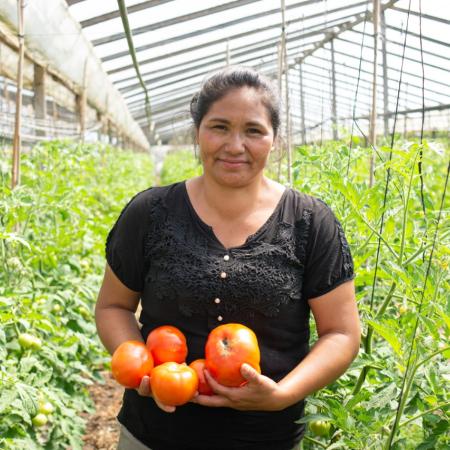
He still remembers the storm of that month of February 2017. The wind suddenly appeared and in a gust as unexpected as it was violent, it blew away the nylons of all the greenhouses, swept away the poles and collapsed the structure of the sheds full of summer crops. In a few minutes nothing was left, "We were ruined and we had no way to start again". Weather tragedies have that loyalty to the calendar.
Sandra Cruz has the mark of that February 5, 2017, the blowing of the wind with gusts of 100 km/h, the furious dance of the nylons flying and shredding through the skies of the quintas. It also has memory of the light, which was cut for hours, for days, for weeks. Of the generator that never arrived, because there was no money to pay for it. And it also has the image of the nothingness that followed, when the harvest was completely ruined and they had no way to start again.
Sandra , born in Bolivia more than four decades ago, came to Argentina at the age of 2, mother of 6 children, agroecological producer since the zero hour of that Aquarian month of 2017, sealed in the productive biography, as the summer in which the greenhouses collapsed and at the bottom of the subsoil of her spirit, dejected with everything that the windstorm took away, said that this way, enough, this way, no. And she dared to do something else.
La Plata is the largest horticultural area in the country. Located in the periurban area of the southern metropolitan region of Buenos Aires, it supplies the main consumption center of Argentina, with a market that exceeds 11.5 million inhabitants. It is a clear example to understand how urban-rural interfaces present tensions related to the use of land and water, the availability of labor, the loss of resources and ecosystemic services that are fundamental for the future, the deterioration of the rural habitat and the urban edge.
When Sandra's entire farm collapsed, she approached a group of producers and heard the word agroecology for the first time.
"If this land were mine, I wouldn't have this need to produce, produce and produce to pay the rent," says Sandra Cruz, "I have to have greenhouses to speed up production and pay the rent and electricity, in addition to my children's schooling. If the land were mine, I wouldn't have so many greenhouses, I do it because I can't pay my bills".
Learn more about Sandra's story: https://bit.ly/3n9rohc

